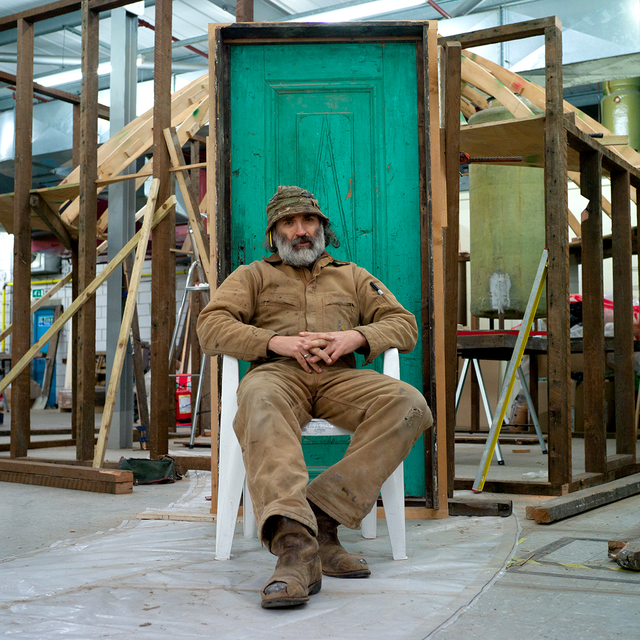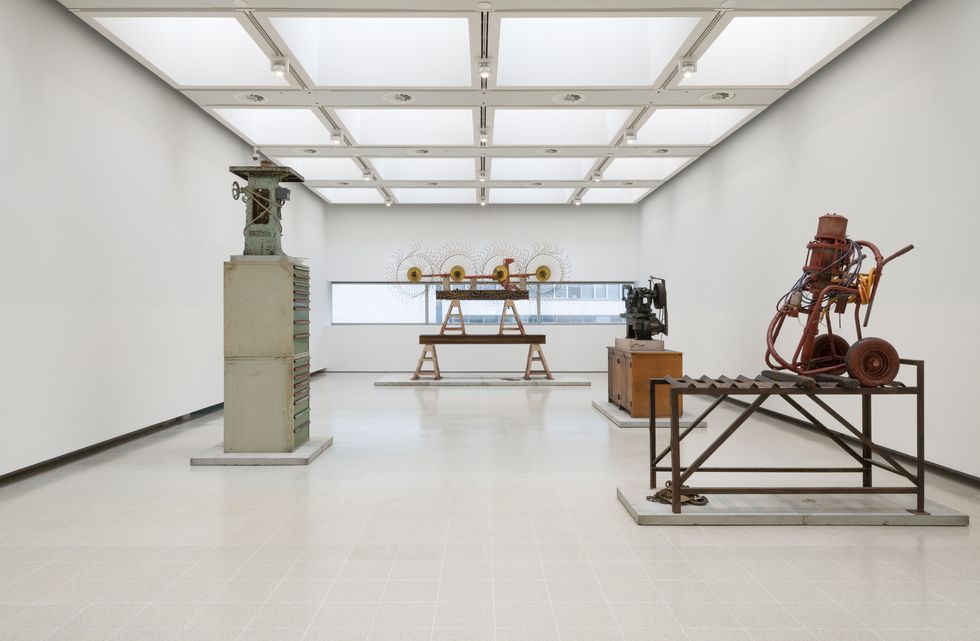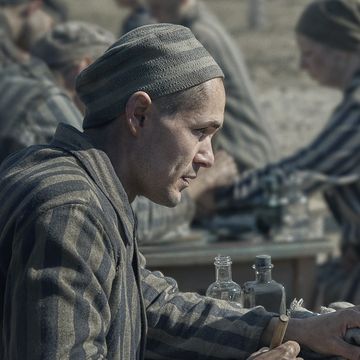Last spring, the artist Mike Nelson went on holiday for a week to the southwest of France. The weather was awful and, on a particularly unforgiving day, when the rain was all but horizontal, he and his partner, the artist Rachel Lowe, and the friends they were staying with took shelter in a small, brutalist museum in the village of Tautavel. The museum, it turned out, was dedicated to the 450,000-year-old Tautavel Man, an ancestor of the Neanderthals, whose remains — the oldest ever found in France —were discovered in a limestone cave, alongside stone tools and animal bones.
“It was just us in the museum and nobody else, and all this Neolithic stuff around us, and these sand-like vistas, and I was thinking, ‘My god,’” says the Loughborough-born Nelson, 55, whose work — often large-scale, immersive installations with unsettling, uncanny atmospheres— has earned him international acclaim and two nominations for the Turner Prize. “It felt like the end of time: some vision at the conclusion of a film where you find yourself washed up in the home of one of the first hominids in Europe,”he says. “I thought: ‘This would be a great feel for the show.’”
The show in question is Extinction Beckons, his imminent solo exhibition at the Hayward Gallery in London’s iconic concrete complex, the Southbank Centre. It will be a survey show, for which he’ll reconsider works he has made over the last couple of decades, right up to “The Asset Strippers”, the stately assemblages of machinery parts salvaged from shuttered factories that he installed in Tate Britain’s Duveen Galleries in 2019. For Nelson — whose breakthrough piece, “The Coral Reef”, first staged at Matt’s Gallery in east London in 2000, was a 15-room installation that led viewers through sets including a dilapidated minicab office, a mechanic’s garage and a security-surveillance office —this was a harder task than it might be for most.
“I was talking to another artist the other day, and I said, ‘I’m doing a show of works at the Hayward and I’m a bit stressed about it,’” says Nelson, who has sharp grey-green eyes and a wild beard and, in his well-worn Goodyear baseball cap and navy-blue woolly jumper, would not look out of place aboard Jacques Cousteau’s Calypso. “They said, ‘Why are you stressed? Why don’t you just ring up all the collectors and get them to send it back and put it in there?’ And I thought, ‘Ah...’”
For Nelson, dusting off existing pieces was not really an option. Because of the scale and ambition of his works, they can be difficult for institutions and collectors to house, plus storage costs can be exorbitant, so those that aren’t bought are often dismantled; sometimes, destroyed. “I’ve built so many shows — it’s madness really — but they all just disappear,” he says. “I suppose I like the fact that the art returns back to the matter it once was, after the exhibition is over. But in commercial terms that’s rather disastrous,” he grins, “because you have to rebuild it every time.”
When we meet in late November, Nelson is spending most of his waking hours in an enormous temporary studio (formerly an Argos warehouse) in Kent, where he and his team are reimagining and reconfiguring the works that will fill the Hayward. They’ll include hugely complex installations — both thematically and logistically — such as “Triple Bluff Canyon” from 2004, a dilapidated woodshed (a nod to the American artist Robert Smithson’s 1970 work, “Partially Buried Woodshed”) onto which Nelson will splice pieces of other past works, before submerging the whole thing in 60 or so tonnes of yellow sand. Or hopes to, anyway. “The quarry’s run out!” he says. “Honestly, it’s a nightmare — we’ve been ringing round everywhere.”
On a ground-floor space in the Hayward, which he says is “just about big enough” to accommodate it, Nelson will install another series of connected rooms called “The Deliverance and the Patience”, a companion piece to “The Coral Reef” that he first constructed in a disused brewery in Venice in 2001 (he also represented Britain there at the 2011 Biennale). The work’s name is borrowed from two 17th-century ships built to convey the survivors of a shipwreck from Bermuda to the new settlement of Jamestown, Virginia; like “The Coral Reef”, it raised questions about the principles by which societies are organised: the networks of religious or political ideologies that extend below the surface.
This time though, he says, he hopes to rebuild “The Deliverance and the Patience”, as a “part-ruin”, familiar to those who’ve seen it before, but with some walls missing, and the outside (“a big, dirty structure made out of timber, with the remnants that aren’t used thrown on the top and hanging off”) now visible for the first time. Not only does making new work out of old work keep things interesting for Nelson, but it explores ideas of history and memory, the way they morph and change. “I’ve had people telling me of spaces they’ve visited that they’ve attributed to my exhibitions that weren’t there,” he says. Does he correct them when that happens? “I do, but in a way the idea of a sort of snowball effect of collecting people’s memories is very appealing, if rather megalomaniacal as well.”
In a so-called “post-truth” age, ideas of memory have a wider cultural relevance, too. “I think it’s so pertinent at the moment in regard to our own histories and to world histories,” he says. “There’s a sense that we’re all starting to doubt ourselves, doubt what we grew up among or in. I hope some sense of questioning one’s own practice might come through too.”
Because the warehouse in Kent is currently full of huge piles of wood and old doors and armatures under construction, Nelson suggests we meet in his regular studio, which is marooned on top of a hill in southeast London close to where he lives with Lowe and their two daughters. I live nearby, and it’s on a street I’ve walked past a hundred times, but behind the unremarkable shop front is not so much an Aladdin’s cave as a Crusoe’s fortress — a rickety space full of half-floors and trapdoors and spiral staircases leading nowhere, filled with amazing curios in every cranny: books, tools, lumps of rock, a mould for a giant bear’s head, shelves full of the bright yellow tins of Nelson’s preferred Turkish brand of Earl Grey tea.
It’s an acquisitive habit that he’s had for a while now; in the early years of his career, having graduated from Reading University and then Chelsea School of Art, he used to scour the salvage yards and markets of east London in his pickup-truck-cum-studio for “detritus” that he would incorporate in his work. It was around this time that he also started reading fiction more seriously, having been force-fed critical theory at art school, which he felt came with “a competitive sense of maleness, which wasn’t really my thing”. Instead, he discovered the works of Soviet science-fiction writers like the Strugatsky brothers and Stanisław Lem — also Ballard and Borges — whose fantastical world-building and dystopian visions went on to inform his thinking; his construction know-how, he says, he inherited from his father, at one time a mechanic on industrial knitting machines, who “could make anything”.
The idea of having a survey show was first raised with Nelson a few years ago, but his father had just died, and he says it felt like too much of an undertaking then. “Even the idea of it now is quite horrific really,” he says brightly. “It takes a lot of energy. Honestly, I look at the work sometimes and it makes me feel tired.” The title of the show, Extinction Beckons, comes from a 1970s motorbike-helmet sticker, and was also the name he used for an early catalogue, though I’d thought it might have been a jokey nod to the retrospective nature of a mid-career show. “It kind of is though, isn’t it,” he says.
Pulling together a survey show has made Nelson reflect in a deeper way too, as he is wont to do. And not just last-few-centuries deep: end-of-the-Anthropocene-era deep. “I do feel like we’re starting to live in digital time instead of human, animal time,” he says, taking a sip of tea. “I think it’s quite confusing for us, because it’s putting history on one level: everything’s the same, because with a click of a button you can be somewhere else, like it’s nothing. Our bodies continue ageing, and yet everything else is frozen in time.”
An exhibition about humanity’s impossible compulsion to preserve the past, told through one man and his recovered remnants — housed in a not-so-small brutalist cultural institution — feels like the right place to ponder it all.
‘Mike Nelson: Extinction Beckons’ is at the Hayward Gallery, London SE1, from 22 February to 7 May; southbankcentre.co.uk

Miranda Collinge is the Deputy Editor of Esquire, overseeing editorial commissioning for the brand. With a background in arts and entertainment journalism, she also writes widely herself, on topics ranging from Instagram fish to psychedelic supper clubs, and has written numerous cover profiles for the magazine including Cillian Murphy, Rami Malek and Tom Hardy.
















